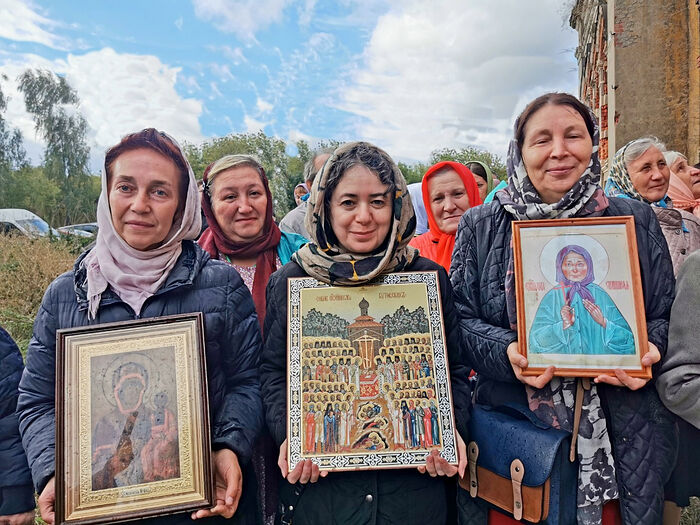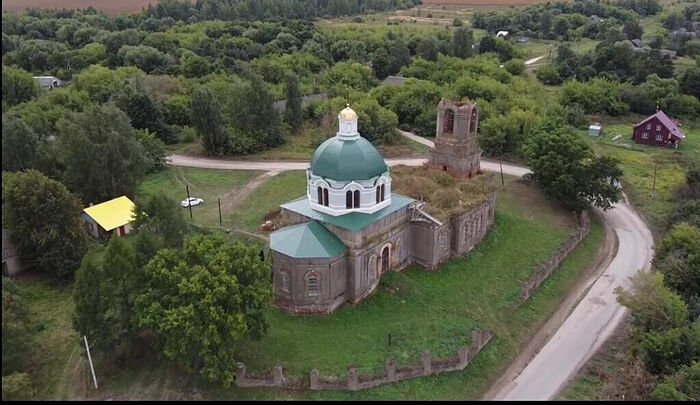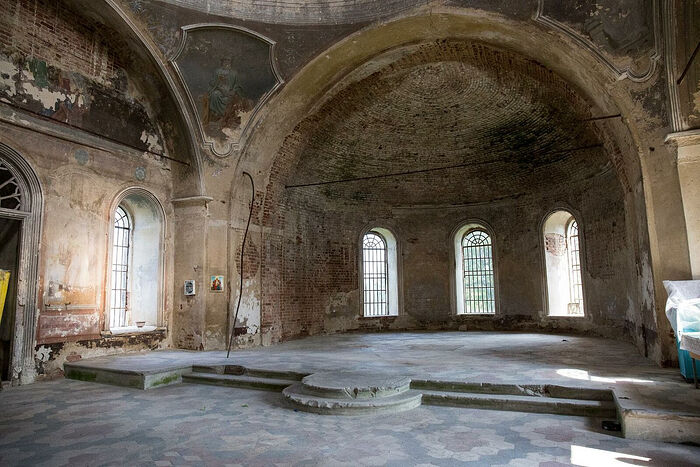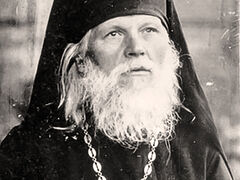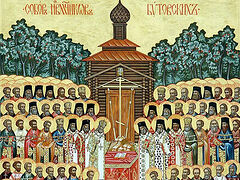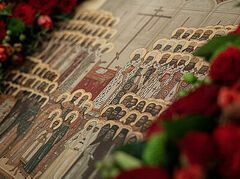The Church of the Theophany in the village of Churiki is one of the largest and most beautiful rural churches in the Ryazan region. The New Martyr Natalia Kozlova, who was executed by firing squad in 1937 at the Butovo firing grange, worked in it and was canonized in 2004. Now the church is being actively restored and needs support.
Churiki is one of the oldest inhabited localities in the Ryazan region. In 1646, the village was mentioned in the Ryazhsk census book as Novy Pochinok Stanovykh.
The road to Churiki is very picturesque, with a wide expanse on both sides, fields, ravines and forests around. Such beauty is breathtaking!
This village has always stood at the frontier between two worlds. There was the Skopin—Mikhailov road, along with a defense made of felled trees and a fortress that guarded the borders. There was a mound behind the Churiki forest, and a wild field behind it. A signal fire was lit on the mound to warn the settlements with smoke whenever danger was imminent.
Churiki used to be a fairly large village, the inhabited not only by peasants, and the peasant community was not homogeneous. Thus, forty-one households had “landowner’s income”—that is, they leased their land to their neighbors. About forty people were artisans who did not have plots of land, and apparently served the village industry—mills, a smithy, and a brick factory.
According to the local village head Pyotr Kondrashkin, by the time the Bolsheviks came to power Churiki was a self-sufficient village. Its inhabitants grew hemp, wove, baked bread, sewed fur coats and made felt boots from local sheep’s wool. Here, right in the village, there were a brick factory, a quarry, a coal mine, and nine mills, one of which was a steam mill.
Now the village of Churiki is relatively small, but it looks pleasant. It is situated five miles from federal Highway R22 (or the “Caspian Highway”), with which it is connected by a good asphalt road. It’s lovely to ride there on a fine autumn day, with golden groves and cultivated fields on both sides.
It is worth stopping the car and looking around the hill in front of the village to marvel at the ability of our ancestors to choose places for their settlements, guided not only by economic reasons, but also by a sense of beauty. Churiki is situated on the high bank of a small river, surrounded by groves burning with autumn gold.
The village houses, with multi-colored galvanized roofs and white stone cellars adjacent, look solid. But there are ruins of a large church to the right of the school. Though they almost completely disappeared. This church was supposed to have been demolished back in 1937, according to the plans of the local union of militant atheists. But one woman got in the way of a powerful ideological and political machine... This was Natalia Ivanovna Kozlova, a peasant woman from the village of Churiki—St. Natalia of Skopin. Once Churiki belonged to the Skopin district. Today it is part of the large Mikhailov district, and the local saint—New Martyr Natalia—is venerated in both the Skopin and the Mikhailov districts.
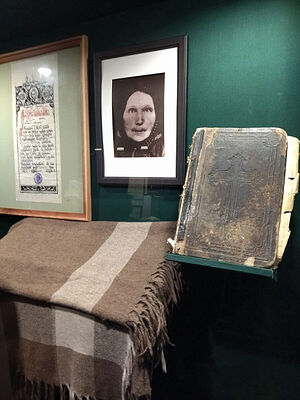 In October 1937, the church in Churiki was damaged by a Komsomol team, which had arrived from Ryazan specially for the occasion. The fire was blazing, with icons, liturgical books and banners burning... But the church survived. It is unknown what exactly did not work out in the plan of the militant atheists, but the church stands to this day. It was built to last, and these walls withstood much and survived to the day when gradual restoration began... And, looking at these walls, you cannot help but recall the words: “O hell, where is thy victory?”
In October 1937, the church in Churiki was damaged by a Komsomol team, which had arrived from Ryazan specially for the occasion. The fire was blazing, with icons, liturgical books and banners burning... But the church survived. It is unknown what exactly did not work out in the plan of the militant atheists, but the church stands to this day. It was built to last, and these walls withstood much and survived to the day when gradual restoration began... And, looking at these walls, you cannot help but recall the words: “O hell, where is thy victory?”
Today there are large-scale local history and expeditionary activities in Churiki. In the tour you can learn firsthand about the areas of local history activities of the Churiki school, familiarize yourself with the most striking projects dedicated to the history of this land and surrounding villages, taste Churiki porridge straight from the oven and marvel while looking at the school museum’s exhibits. The museum in Churiki is the pride of the teams of teachers and students. You can see rarities in it, and through amazing exhibits learn more about the life of our ancestors of many years ago. And at the museum you can learn about the history of the Church of the Theophany and its warden—Martyr Natalia Kozlova.
On her feast-day, September 14, numerous pilgrims from Mikhailov, Moscow and Ryazan flock to this remote village.
The history of the church
The history of the church in Churiki is rather curious. At first it was wooden, as was often the case. But in 1837 it was destroyed when lightning hit the bell tower. The replacement wooden church stood for only half a century and fell down on its own. In 1878 it was decided to build a stone church here. The initiator of the construction was Priest Fyodor Cherkasov, who served in the village for forty-eight years, and his work was continued by his son, Fyodor Fyodorovich. Fr. Fyodor also taught the Law of God in the zemstvo1 school, and perhaps it was he who awakened Christian feelings in the young student Natalia. The priest’s son, Priest Fyodor Fyodorovich Cherkasov, would be shot on November 21 at the Butovo firing range, as would Natalia, the churchwarden. A mother of eight children, Natalia Kozlova was a native of the village of Churiki and struggled against the authorities in the 1930s to keep the church open. Besides them, four more natives of the village of Churiki were martyred in Butovo: Vasily Matveyevich Abramkin, Vasily Danilovich Orlov, Alexei Fyodorovich Kufakov, and Terenty Efimovich Lobanov. Thus, the village of Churiki is the birthplace of six people who suffered for their faith.
The stone church with a total area of over 1000 square meters (10,763 sq2) with the main altar in honor of the Theophany and two more chapels in honor of St. Nicholas the Wonderworker and the holy Princes Boris and Gleb was built between 1874 and 1878. It is one of the largest and most beautiful rural churches in the Ryazan region. The author of the project was probably the architect Nikolai Nikolaevich Weiss from the Ryazan province.
The church was built of local bricks, which were fired at the Churiki brick factory and molded with local clay extracted at the Churiki quarry. There is an assumption that the masonry was made by Turks who were wonderful builders but understood little about Orthodox church architecture. Indeed the masonry under the dome is uneven. However, given the fact that the dome has not yet collapsed, the builders must have been talented. But who covered the walls with paintings?
“Even before the Revolution, at the beginning of the twentieth century, Priest Cherkasov tried to fight alcoholism in the village. He even ordered a wonderworking icon,” the head of the rural locality, Pyotr Kondrashkin, recollects the accounts of locals. “And he had great success. People gave up drinking—they began to wonder why their lives were so bad. Tea rooms and gramophone rooms appeared, where people held secular conversations. In his letters of 1914 to the senior clergy Cherkasov literally predicted the future Revolution.
“The revolutionaries foreseen by the priest blocked up a church window with the icon that helped against alcoholism so the building would be suitable for use as a warehouse. All the stained-glass windows were smashed. People stopped going to the church, and tractors began to drive into it. Grain and potatoes were stored here. They didn’t destroy the church simply because the new authorities really liked this spacious building.”
In 1933, the Church of the Theophany in the village of Churiki was closed and used as a granary despite the protests of believers. The bells were thrown down and sent to be melted down, the interior adornments were burned, the church’s defenders were dispersed and many of them killed. For two thirds of the twentieth century the imposing building was systematically damaged and deformed, but the edifice survived. It had been built to last, and its walls have seen and withstood a lot. By the grace of God, several wall paintings have remained in the church. One of them is opposite the main entrance—it’s a wonderful, beautiful image! Just imagine that the entire church was once covered with paintings like that!
The church has a vaulted ceiling. Its architectural style is eclectic. Very few of such amazing, impressive churches have survived. You can barely tear your eyes away from the helmet-shaped dome, perfect in its proportion and striking in its grandeur and extraordinary beauty.
So, we have lived to see the day when, after almost eighty years and through the efforts of real heroes, its gradual revival has begun. And with the revival of the church our memory is also being revived—we want to know what the church was like, who served in it, who built and restored it, who prays in it now, and who worshipped in it 100 or 200 years ago. Documents, photographs, letters and stories from elders and our childhood memories have survived—everything is interesting and will come in handy.
To be continued…

